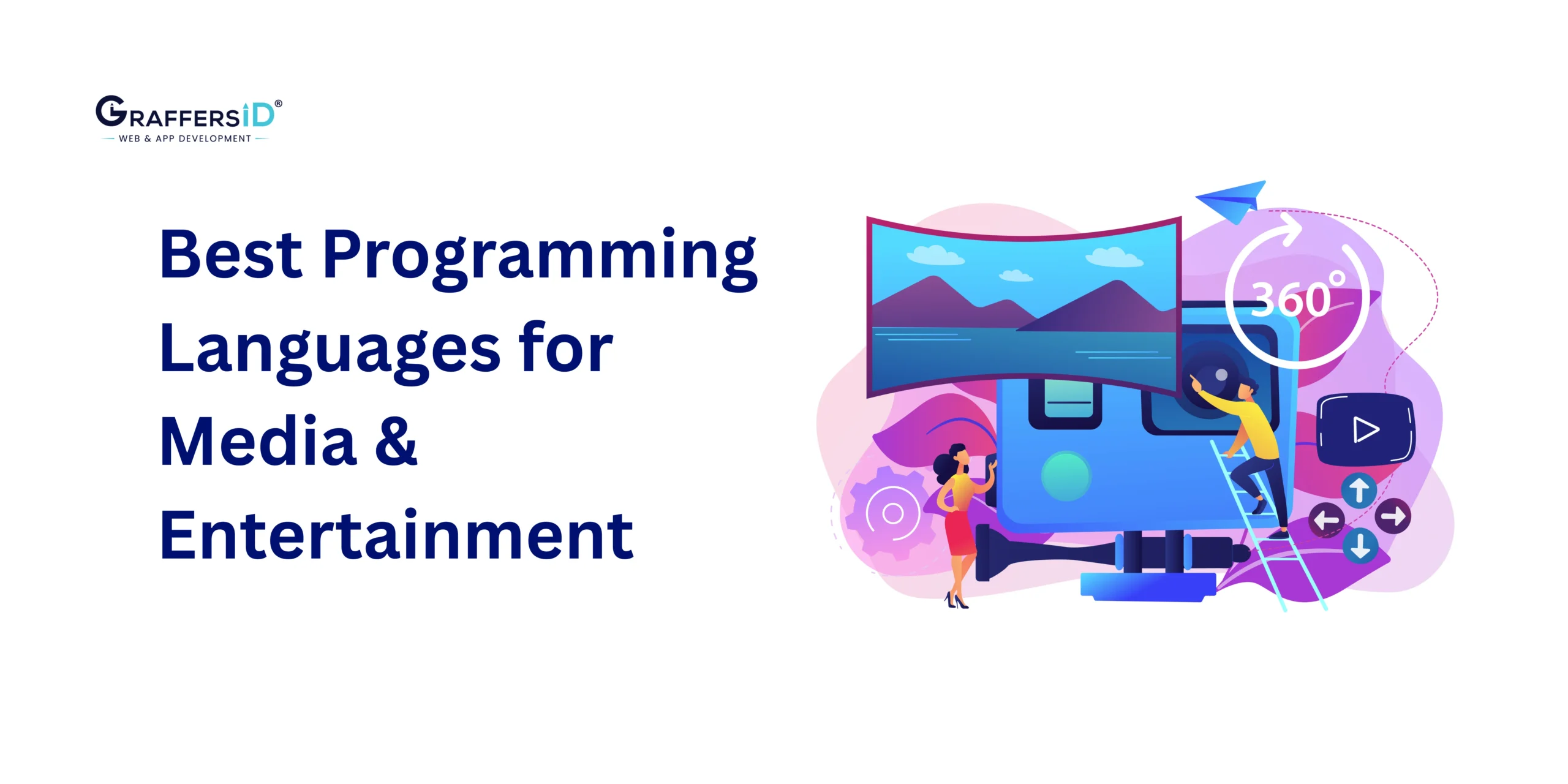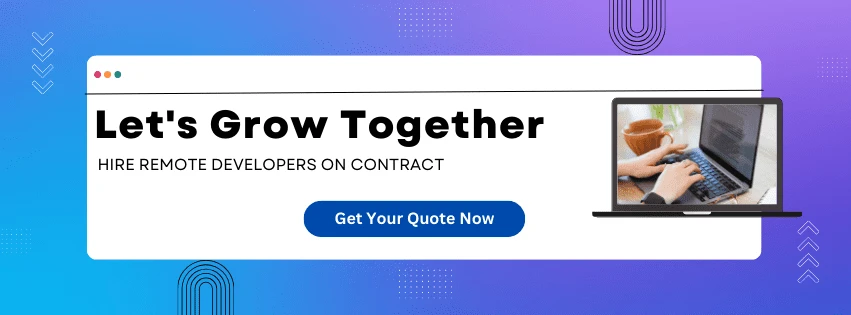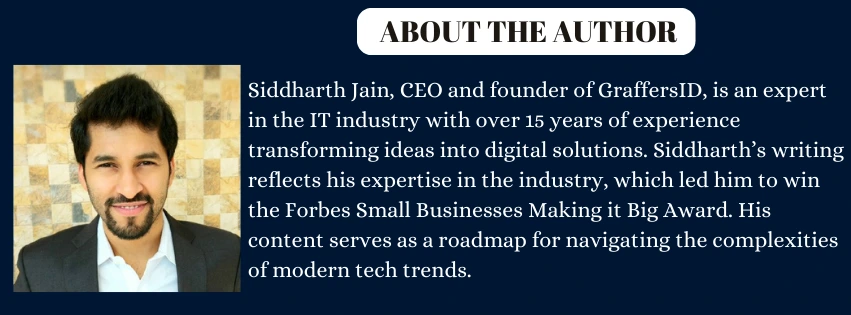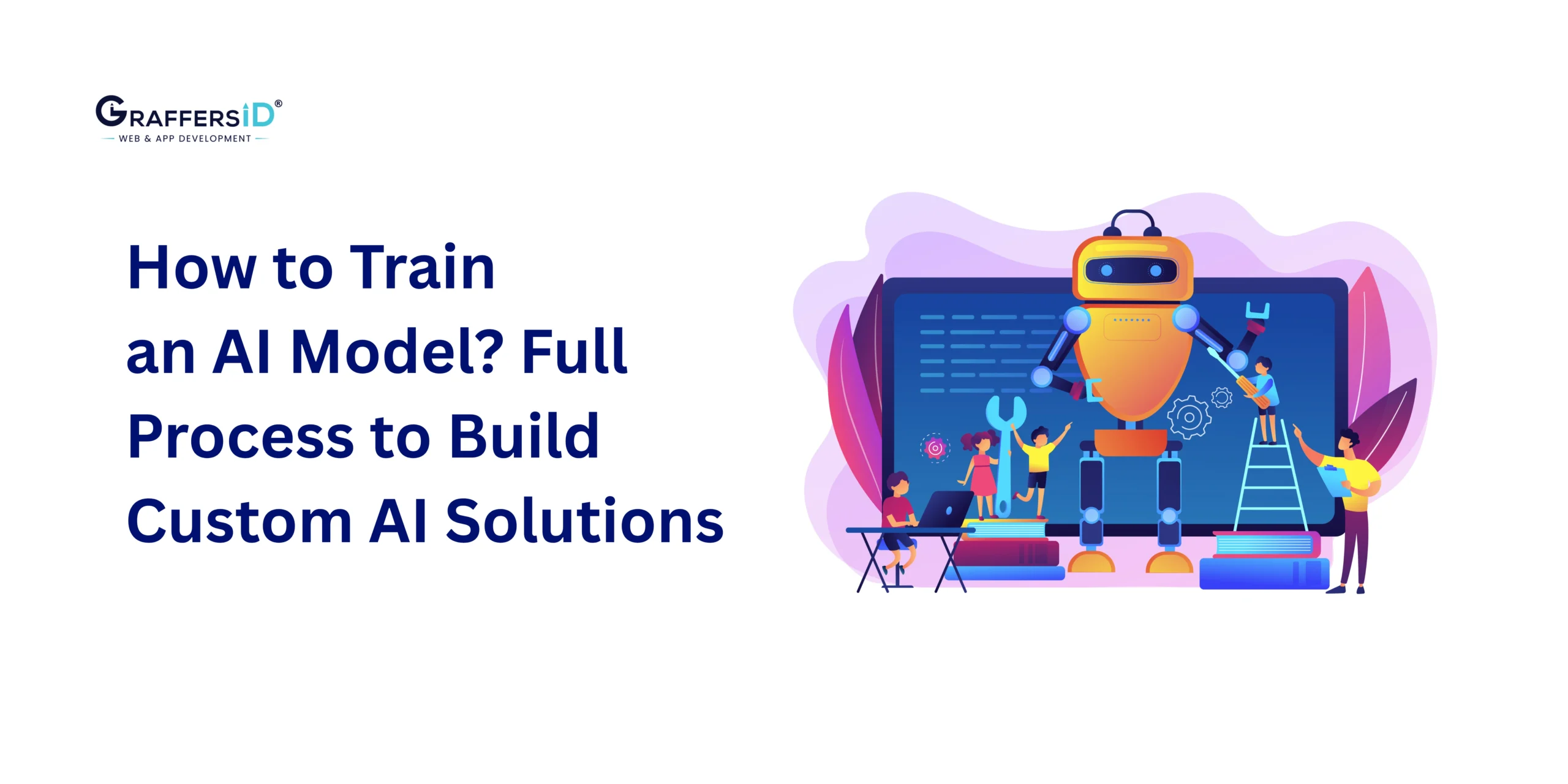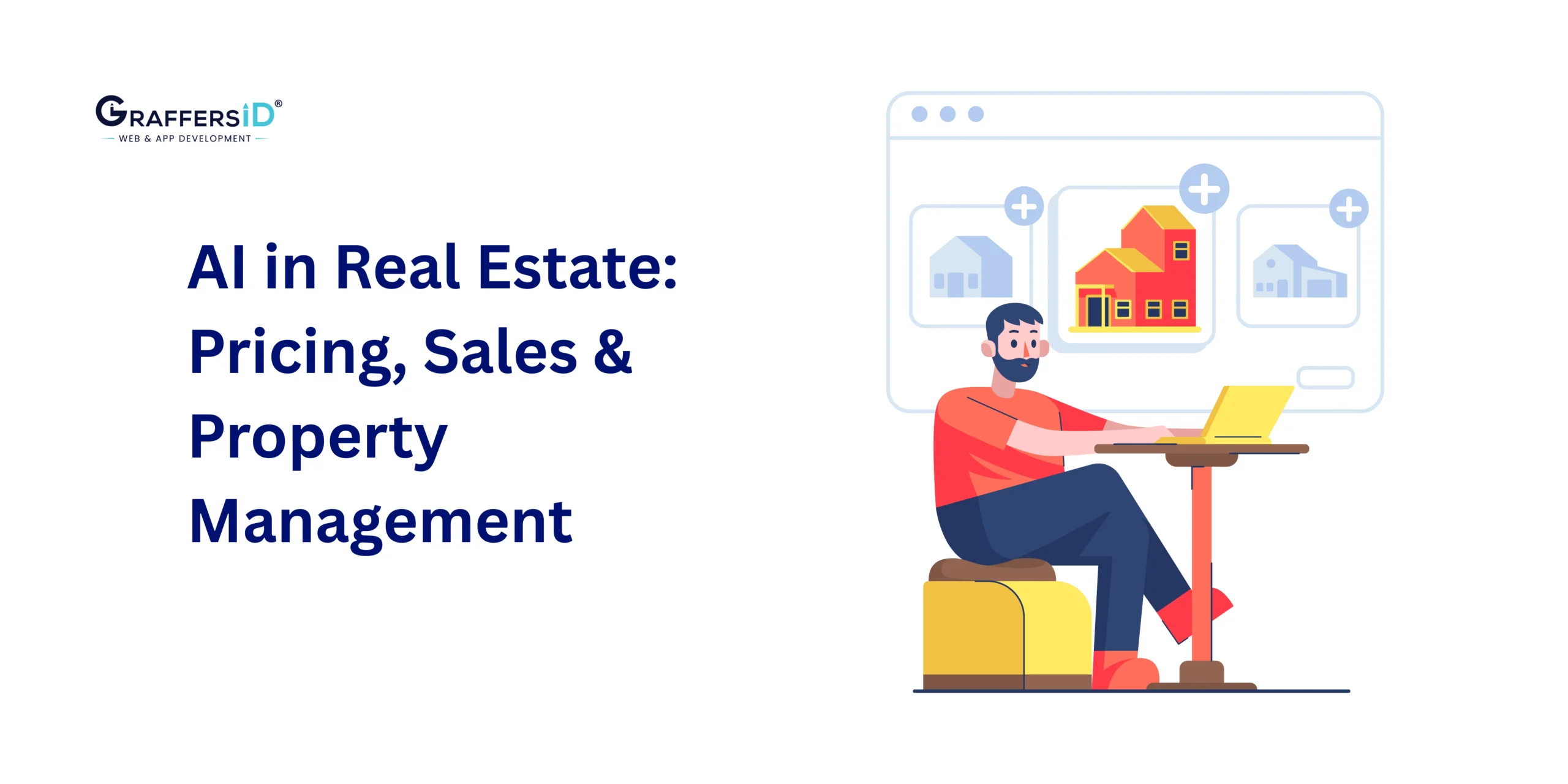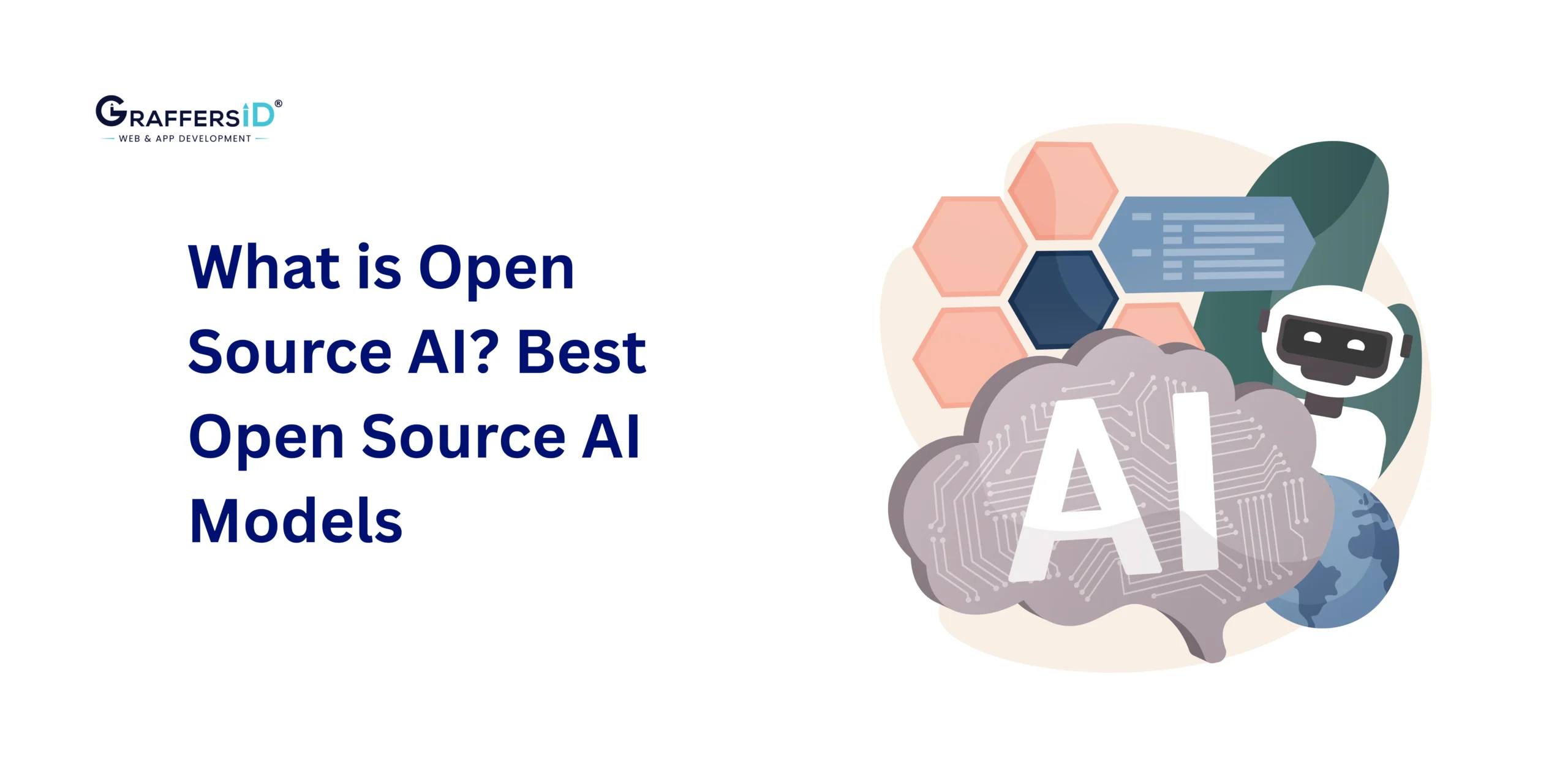The media and entertainment landscape in 2026 is transforming at lightning speed. From AI-powered video editing and personalized recommendation engines to immersive AR/VR experiences and real-time streaming platforms, user expectations are higher than ever.
The right language ensures smooth performance, scalable architecture, AI integration for automated editing, content personalization, predictive recommendations, robust security, and DRM to protect digital content from piracy.
In this guide, we’ll explore the 7 best programming languages for media and entertainment in 2026, diving into their frameworks, AI capabilities, and real-world applications, so you can make the smartest tech choices for building future-ready, high-performance media apps.
Why Choosing the Right Language Matters for Media & Entertainment in 2026?
Developing applications for the media and entertainment sector involves a programming language that can support high-performance computing, real-time content delivery, AI-based automation, and security issues. The proper choice impacts:
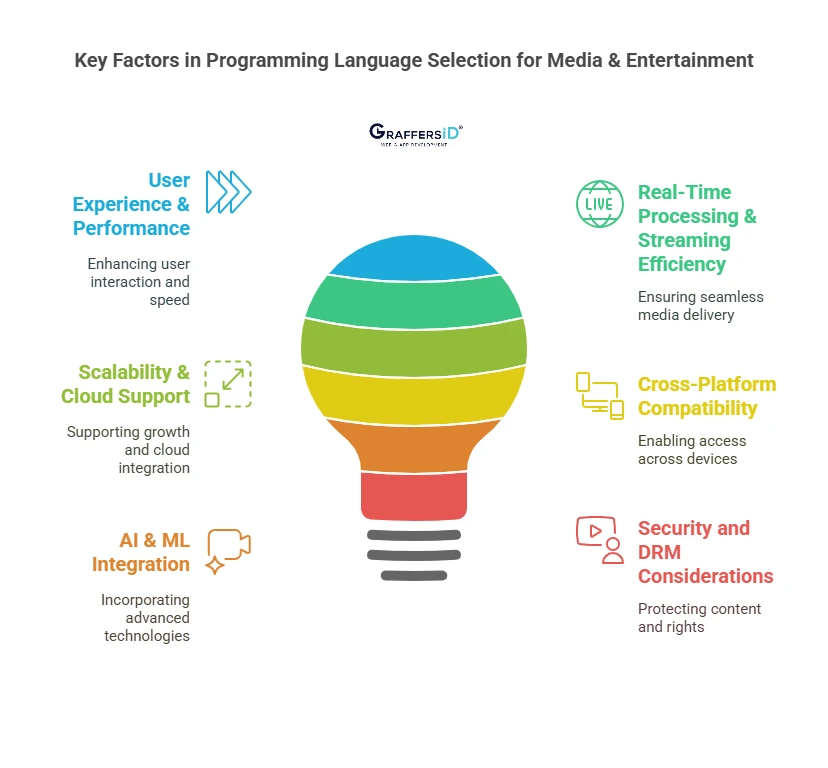
1. User Experience & Performance
- Optimized languages ensure high-resolution videos and gaming run without buffering or lag.
- Fast, responsive UIs keep users engaged and reduce churn on streaming and gaming platforms.
2. Real-Time Processing & Streaming Efficiency
- Efficient memory and concurrency management enable smooth live streams and multiplayer gaming.
- Real-time rendering supports live chats, comments, and dynamic content without delays.
3. Scalability & Cloud-Native Support
- Languages compatible with cloud services like AWS, Azure, and Google Cloud ensure worldwide content delivery.
- Cloud-native apps scale automatically to handle millions of simultaneous users.
4. Cross-Platform & Multi-Device Reach
- Apps run smoothly on iOS, Android, smart TVs, VR/AR devices, and web browsers.
- A single codebase across platforms reduces development time and ensures consistent UX.
5. AI & ML Integration
- AI-driven recommendation engines deliver tailored content like Netflix or Spotify.
- Generative AI enables video editing, captions, effects, and even full content creation.
6. Security & DRM (Digital Rights Management)
- End-to-end encryption and watermarking safeguard media assets from piracy.
- Decentralized ownership and smart contracts ensure fair royalty distribution and secure content licensing.
Top 7 Programming Languages for Media & Entertainment Development in 2026
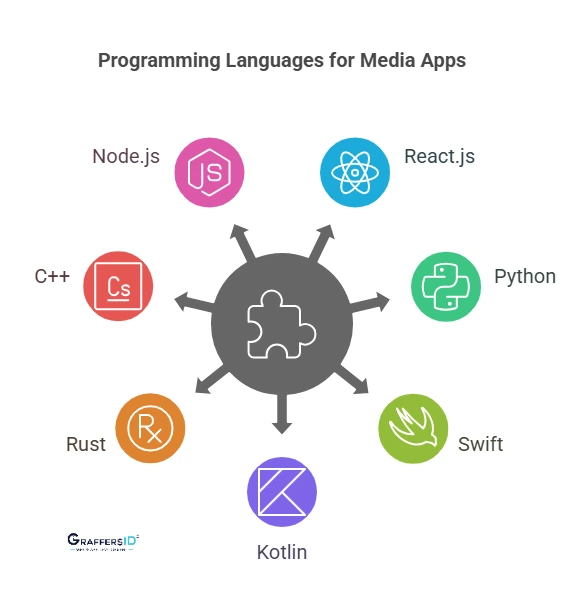
1. React.js: Best for Interactive Web & Streaming Platforms
React.js remains the front-end powerhouse for OTT and media apps. With its Virtual DOM, React enables fast UI rendering and real-time updates, ideal for content-heavy apps like Netflix, Spotify Web, and YouTube.
Key Frameworks & Tools of React.js
- Next.js: Enhances React.js with server-side rendering (SSR) and static site generation (SSG), which improves SEO and initial load performance for content-heavy sites.
- Three.js: A JavaScript library for creating 3D animations and AR/VR experiences.
- React Native: Allows cross-platform mobile applications, allowing media applications to function smoothly on both iOS and Android.
- Redux: A state management solution that helps in managing dynamic media states (live comments, real-time playlists), making it suitable for large-scale applications that require dynamic content updates.
- Gatsby.js: A static site generator designed to create static media websites with optimized performance and GraphQL support.
Use Cases of React.js
- Netflix UI, YouTube, and Spotify’s interactive platforms.
- Live video streaming with real-time reactions and chats.
- Digital magazines and news portals.
Looking to build scalable, interactive streaming apps? Hire expert React.js developers from GraffersID.
2. Python: AI & Data-Driven Media Apps
Python powers AI, ML, and automation, making it the backbone of recommendation engines, video analysis, and AI content creation. Its adaptability and ease of integration with AI models allow for smooth deployment in industrial settings.
Key Frameworks & Tools of Python
- TensorFlow, PyTorch, Keras: Advanced deep learning frameworks used for AI-powered media applications, including recommendation engines & generative AI.
- OpenCV: An image and video processing toolkit commonly used for object detection, face recognition in video content.
- Flask & Django: Web frameworks that allow backend development for scalable media applications, such as AI-driven streaming services.
- MoviePy: A Python library for programmatic video processing and editing, ideal for the automated creation of media content.
- Pandas & NumPy: Needed for data processing and content analysis, which enhance content recommendations and audience insights.
Use Cases of Python
- Netflix & Spotify’s AI-driven recommendation systems.
- Automated video editing, deepfake detection, and AI-generated content.
- Security features (facial recognition, video tagging).
3. Swift: Best for iOS Media Applications
Swift dominates Apple ecosystem media apps (iOS, iPadOS, macOS, tvOS). With AVFoundation + ARKit, it enables native, secure, and high-performance video/audio playback.
Key Frameworks & Tools of Swift
- AVFoundation & CoreMedia: Used for high-speed media playback, real-time audio/video processing, and DRM-protected content streaming.
- RealityKit & ARKit: Essential for developing AR/VR-powered content for immersive media experiences.
- SpriteKit & SceneKit: Frameworks for 2D/3D game development within the iOS ecosystem, supporting high-quality graphics and animations.
Read More: What is Generative AI and How Does It Affect Software Development?
Use Cases of Swift
- Apple Music, iMovie, and Final Cut Pro.
- iOS streaming platforms with secure DRM.
- AR-powered media apps for interactive storytelling.
4. Kotlin: Android Media Applications
Kotlin, the official Android language, powers top apps like Disney+ Hotstar and Prime Video. With concise syntax and better memory handling than Java, it’s ideal for media-heavy apps. Better memory management and performance make it perfect for resource-consuming media apps.
Key Frameworks & Tools of Kotlin
- Jetpack Compose: A modern Android UI toolkit for creating interactive and fluid user interfaces in Android media applications.
- ExoPlayer: A custom video player supporting adaptive streaming, DRM, and high-resolution playback.
- Ktor: A synchronous and lightweight backend service framework suitable for media apps that need real-time data processing.
- CameraX: A framework to extend camera capabilities to media apps like live streaming and video creation.
Use Cases of Kotlin
- OTT apps with smooth video playback.
- Mobile-first video editing and social media apps.
- Music streaming & live broadcasting.
5. Rust: High-Performance & Secure Media Processing
Rust is rising in performance-sensitive media apps like VR, AR, and real-time video streaming. Its low-level control allows it to execute latency-sensitive applications, such as video streaming and gaming engines, and DRM systems efficiently.
Key Frameworks & Tools of Rust
- Bevy, Tokio & Actix: Used to create high-performance media applications and game engines using parallel processing and concurrency.
- FFmpeg & GStreamer: Frameworks for real-time audio/video encoding.
Use Cases of Rust:
- VR/AR-based streaming platforms.
- Secure DRM systems against piracy.
- High-performance compression engines.
6. C++: Game Engines & Video Editing
C++ gives direct hardware access, which allows it to power AAA games, 3D rendering, and video editing software. It’s commonly used in game development and real-time simulation applications.
Read More: Most in Demand Programming Languages in 2026
Key Frameworks & Tools of C++
- Unreal Engine & Unity: Frameworks for game development, and real-time video processing.
- OpenCV: Used in computer vision in gaming/streaming.
Use Cases of C++
- Fortnite, PUBG, and Call of Duty (AAA games).
- Adobe Premiere & After Effects real-time rendering.
- 3D modeling, simulation, and real-time VR.
7. Node.js: Scalable Backend for Media Streaming
Node.js is the backend engine for real-time, non-blocking streaming apps. With its event-driven model, it handles millions of concurrent viewers efficiently.
Key Frameworks & Tools of Node.js
- Express.js: Used for live interactions, scalable APIs, and real-time streaming for OTT platforms.
- Nest.js: A modular backend for creating large apps.
- Socket.io: Framework used in real-time chat, reactions & multiplayer gaming.
Use Cases of Node.js
- Twitch live streaming backend.
- Media asset management systems.
- Interactive OTT platforms with low latency.
Need a scalable backend for your streaming platform? Hire Node.js developers from GraffersID to build secure, high-performance solutions.
Comparison Table: 7 Best Languages for Media & Entertainment (2026)
| Language | Best For | Key Strengths | Notable Use Cases |
|---|---|---|---|
| React.js | Web-based streaming | Fast UI, real-time rendering | Netflix, YouTube |
| Python | AI-powered media | ML libraries, automation | Content recommendation |
| Swift | iOS apps | Secure, high-performance | Apple Music, iMovie |
| Kotlin | Android apps | Concise, robust | Hotstar, Prime Video |
| Rust | High-performance media | Memory safety, speed | VR/AR apps |
| C++ | Gaming & editing | Hardware control, graphics | Unreal, Premiere Pro |
| Node.js | Backends & streaming | Real-time, scalable | Twitch, OTT platforms |
Future Trends in Media & Entertainment Development (2026 & Beyond)
As technology advances, some important factors are expected to affect the future of media and entertainment software development:
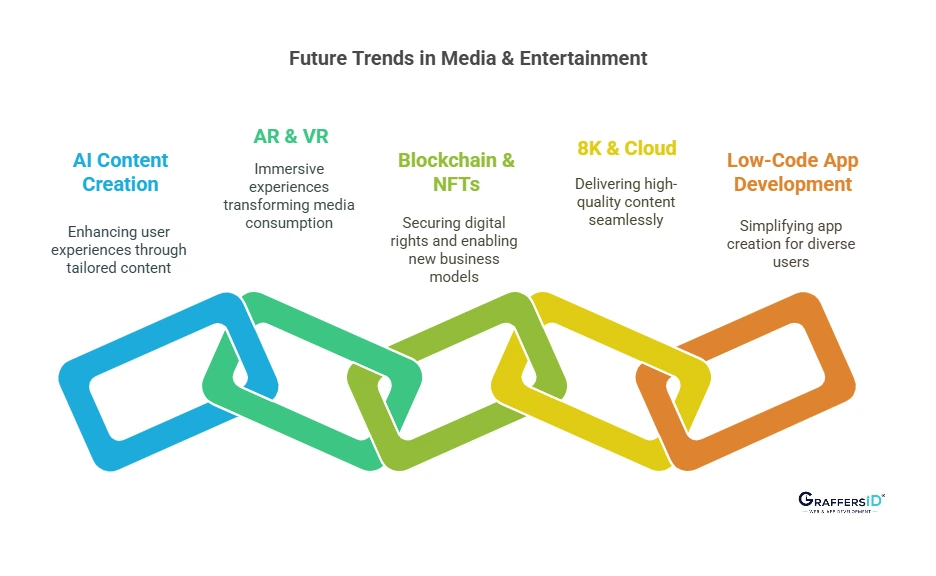
1. Generative AI in Content Creation
- AI-powered tools are automating video editing, voice synthesis, and scriptwriting, changing content creation.
- Machine learning algorithms improve tailored suggestions, which increases user engagement on sites such as Netflix, YouTube, and Spotify.
- Personalized ads and storytelling powered by LLMs.
2. Immersive Tech (AR/VR/XR + Metaverse)
- AR and VR technologies are developing realistic experiences for gaming, live concerts, and AR-enhanced sports streaming.
- AR is being used on social media platforms to enhance interactive storytelling and digital advertising.
- Metaverse-based entertainment hubs are creating more options for virtual entertainment centers and digital events.
3. Blockchain & Web3 in Media
- Blockchain technology ensures secure transactions and decentralized content delivery, which reduces piracy threats.
- Non-fungible tokens (NFTs) based ownership of music, movies & assets ranging from music songs to movie treasures.
- Smart contracts for royalty distribution, ensuring that artists and producers are fairly compensated.
4. 8K & Cloud-Streaming
- With the growing demand for ultra-high-definition (Ultra-HD) streaming, content providers are investing in 8K video capability.
- Cloud-native low-latency streaming technologies allow for low-latency playback and worldwide content distribution.
- AI-enhanced video streaming improves the quality of lower-resolution content.
5. Low-Code/No-Code Media Development
- AI-assisted low-code tools for creators allow for faster content development and delivery.
- Democratizing media app development, making media technology more accessible to entrepreneurs and individual creators.
Conclusion
The media and entertainment industry in 2026 is being reshaped by AI-driven personalization, immersive AR/VR, scalable cloud streaming, and advanced digital rights management (DRM).
Building future-ready platforms requires choosing the right programming language, whether it’s React.js for user interfaces, Python for AI and automation, Kotlin/Swift for mobile apps, Rust or C++ for high-performance gaming, or Node.js for scalable backends.
Enterprises that adopt the right tech stack today will stay ahead in delivering seamless, secure, and engaging digital experiences to a global audience.
GraffersID empowers businesses to build next-generation media and entertainment applications by providing skilled remote developers with expertise in AI, AR/VR, mobile, gaming, and backend technologies.
Hire expert developers from GraffersID today and transform your media platform into the future of digital entertainment. Contact us today!
